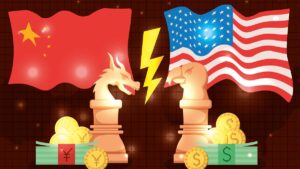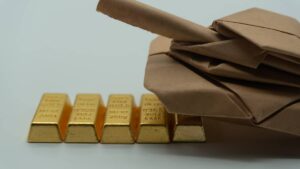Could Tsingshan’s battery nickel breakthrough keep a lid on nickel prices?

Pic: Bloomberg Creative / Bloomberg Creative Photos via Getty Images
Chinese nickel giant Tsingshan has again emerged as the bogeyman of the Australian nickel industry after the company last week announced commercial production of nickel matte in Indonesia.
It plans to supply around 100,000t of nickel matte each year to Huayou Cobalt and CNGR.
The news gave a haircut to nickel prices which have been trading around seven-year highs on both supply tightness and the emergence of demand from the battery sector.
Prices fell 0.6% to US$19,862/t on Friday.
It follows a dramatic one-month price drop earlier this year from $20,110/t on Feb 22 to $15,948/t on March 30 after Tsingshan announced its plans to produce intermediate nickel matte, which is later processed into battery chemicals, from mines traditionally used to supply nickel pig iron to steelmakers.
While batteries only account for 7% of demand currently, the sector’s share could rise more than fourfold by 2040 according to WoodMac.
That’s viewed as a positive for Aussie producers who either own nickel sulphide mines – simple to process and readily convertible to battery quality nickel sulphate – or established nickel laterite operations where the exorbitant capex on high pressure acid leach plants was already sunk long ago.
Case in point, Elon Musk’s EV giant Tesla hit up BHP’s WA-based Nickel West for nickel sulphate, with the mining giant using blockchain to trace its emissions and ESG performance.
But there are new fears Indonesian operations could disrupt the positive outlook for nickel prices by reducing the expected supply shortfall in the decade to come.
Ten years ago the flood of Chinese-sponsored production from Indonesia’s laterite mines saw hundreds of thousands of tonnes of cheap NPI enter the market.
That put serious downward pressure on prices and made most Australian miners unprofitable.
But NPI was only good for stainless steel production – currently 70% of the nickel market, and expected to fall to just over half of downstream demand by 2040.
News Tsingshan and other Chinese companies are moving into the emerging battery market raises the spectre history may repeat, cutting the EV-led renaissance for Aussie nickel off at the knees.
Long-lasting implications: analyst
Commbank mining analyst Vivek Dhar said in a note yesterday Tsingshan’s breakthrough may have long-lasting impacts on the nickel market.
Most of the world’s nickel is contained in lateritic orebodies, although nickel sulphide mines are the Rolls Royces of the nickel world because they are higher in grade, easier to mine and cheaper to build and operate.
If Tsingshan and other Chinese companies have found a way to develop HPAL projects cheaper and quicker than before it could increase supply and eat into nickel sulphide’s competitive advantage.
“Tsingshan’s success in producing battery grade nickel in Indonesia from low grade nickel laterite ore has potentially long lasting implications for the nickel sector,” Dhar said.
“Historically some of these HPAL projects have resulted in very high capital costs and significant delays.
“Tsingshan’s success to produce battery grade nickel comes as a number of HPAL projects come online in Indonesia.
“In fact, China’s Ningbo Lygend started trial production at its HPAL plant in late April.”
Nickel sulphide mines like those owned by IGO (ASX:IGO), Poseidon (ASX:POS), Western Areas (ASX:WSA), Panoramic Resources (ASX:PAN) and Mincor (ASX:MCR) are in short supply.
“Sulphide ores are generally a lower cost pathway to produce battery grade nickel,” Dhar said.
“However, it is widely expected that sulphide ores will likely struggle to meet the demands of the battery sector alone.
“The nickel industry has therefore looked at finding a reliable, low emission and low cost pathway to produce battery grade nickel from laterite ores.”
It comes with battery makers also looking to increase the nickel composition of their batteries to provide more energy density and, in the context of EVs, longer range.
“In 2020, the most popular nickel manganese cobalt (NMC) battery chemistries deployed in passenger vehicles are in ratios of 6:2:2,” Dhar said. “By 2030, this ratio is expected to increase to 9:0.5:0.5.”
Will Tsingshan’s process put a lid on prices?
What impact the development will have on prices will come largely down to costs, Dhar said.
“The significance of Tsingshan’s production process will come down to the costs it has managed to achieve.
“If the process is as low cost as Tsingshan had indicated in March this year, lower long term nickel prices are a real possibility.
“It’s worth noting that the process is not new – Eramet and Vale have achieved success in a similar production process (i.e. converting ferronickel to nickel matte, a nickel product suitable for the battery sector).”
However, EV makers are also looking for nickel sourced within ESG friendly supply chains with low emissions.
Given HPAL is an energy-intensive process, that could pose an issue for car and battery makers facing pressure from investors to limit scope 1, 2 and 3 emissions.
“However, the Tsingshan processing breakthrough may yet prove unviable,” Dhar said.
“The nickel matte product is anticipated to release a high level of carbon emissions due to its double pyrometallurgical process route.
“With the Electric Vehicle (EV) sector looking to reduce global carbon emissions, the risk is that Tsingshan’s process breakthrough may be overlooked because the EV sector may choose a more expensive pathway that releases lower carbon emissions.”
Western nickel producers have been scrambling to signpost their ESG-friendly credentials as well.
“According to a third party analysis, our Nickel West asset has one of the world’s lowest operational carbon emissions intensities for nickel mining operations and plans to further reduce emissions, making BHP a partner of choice to battery electric vehicles manufacturers across the globe that value sustainability and transparency,” BHP chief commercial officer Vandita Pant said in an article by BHP yesterday.
An Aussie cornering the other fighter
The clamouring for nickel sulphide assets is underlined by the mad takeover tussle between BHP and Andrew Forrest’s Wyloo Metals over Canadian nickel explorer Noront Resources.
Suitors are also hovering around a host of mid-tier nickel companies closer to home.
IGO has been in drawn-out discussions with Western Areas for several weeks over a merger while Forrest has built stakes in WSA, Mincor and Poseidon.
If the Indonesian mines do manage to access the battery market, one Australian miner who could benefit is $3.5 billion capped Nickel Mines (ASX:NIC).
While the firm is headquartered in Sydney it is, to use a sports analogy, sitting in the away stand, and plans to triple its NPI production in Indonesia to 100,000tpa by 2023.
Nickel Mines recently expanded an MoU with Shanghai Decent Investment Group that will give Nickel Mines a 70% share in the 36,000t Oracle Nickel Project and participation in future HPAL and renewable energy projects.
Nickel stocks share price today:
Related Topics
UNLOCK INSIGHTS
Discover the untold stories of emerging ASX stocks.
Daily news and expert analysis, it's free to subscribe.
By proceeding, you confirm you understand that we handle personal information in accordance with our Privacy Policy.








